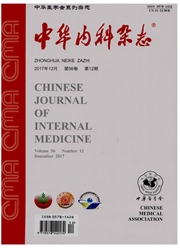

 中文摘要:
中文摘要:
目的通过分析特发性淋巴细胞性间质性肺炎(LIP)的临床、影像、病理特征,探讨其诊断方法、治疗措施,提高临床工作者对其的认识。方法回顾性分析3例经肺活检证实的特发性LIP患者的临床表现、胸部X线和CT、病理资料及诊治过程,并文献复习。结果特发性LIP患者的主要临床表现为干咳、呼吸困难,常伴有高球蛋白血症;胸部影像学改变主要是双肺弥漫分布的小结节影和小囊肿;病理特征是以多克隆淋巴细胞尤其是B淋巴细胞浸润为主的弥漫性间质性炎症。主要治疗手段是糖皮质激素联合细胞毒药物,治疗反应良好。结论LIP临床、影像和病理表现有一定特征性;最可靠的诊断方法为临床-影像-病理诊断;糖皮质激素和细胞毒药物联合治疗效果良好。
 英文摘要:
英文摘要:
Objective To analyze the clinical, radiological and pathological characteristics of idiopathic lymphoid interstitial pneumonia (idiopathic LIP) and to discuss its diagnosis, treatment and prognosis. Methods Respiratory physicians, pathologists and radiologists together retrospectively analyzed the clinical, chest roentgenogram, computerized tomography, pathological, diagnostic and therapeutic data of 3 patients with idiopathic LIP confirmed by lung biopsy, and reviewed the relevant literatures. Results The major symptoms of the 3 cases of idiopathic LIP were prgressive dyspnea and dry cough. Higher levels of γ-globulins in serum were found in all the cases. The characteristic radiographic manifestations were bilateral diffuse nodules and cysts. The pathologic feature was diffuse interstitial inflammation with polyclonal lymphocytes infiltration, especially with plasma lymphocytes. Corticosteroids and cytotoxic agents were used and good response to therapy was observed in the cases. Conclusions Idiopathic LIP has some characteristics on the clinical, radiological and pathological features, but the best diagnostic method depends on a clinical-radiological-pathological approach. The disease usually shows good response to combinative therapy of corticosteroids and cytotoxic agents.
 同期刊论文项目
同期刊论文项目
 同项目期刊论文
同项目期刊论文
 期刊信息
期刊信息
